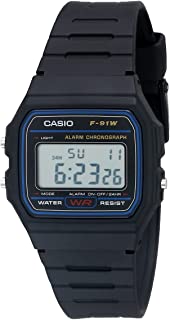So, on what wrist does a man wear a watch? What hand do you wear a watch on? Wearing a watch is a habit, and everyone has their ‘preferred’ side. Some like it on the left, some like it on the right.
The best way to wear your watch is on your non-dominant hand. If you are right-handed, you wear your watch on your left and vice versa. This helps to protect your watch from impact and damages since your dominant hands are usually the one doing the majority of work.

The Common Answer
Google around and you will see the common advise:
“wear your watch on your left wrist.”
But why the left wrist? Why not right?
Turns out that there are actually reasons for this recommendation.
Historical Background
Historically, most men carried pocket watches from the 19th century to around the First World War in the 1910s.
Some men carry these watches around in a leather pouch to protect them, as these watches can be fragile.
To access the watch easier the leather pouches are often strapped to the wrist. The trend was to strap the watch to the less-dominant hand to further protect the watch.
Since most people are right hand dominant, these watches were strapped to the left wrist.
This practice continued into wristwatches, which bring us to the common advice today.
Now that we have established the historical reasons people wear their watch on the left hand let’s rethink the whole thing now.
Left vs Right Wrist
The rule above seems to work well if you are right hand dominant and have your watch on the left.
But how about if you are a southpaw (left hand dominant)?
Would you still wear your watch on your left wrist?
There might be apparent issues such as difficulty putting the watch on.
Try using your non-dominant hand to put on a watch on your dominant wrist.
Plus, it might hinder your movement too, since wearing your watch on your left wrist means you will have to carry the watch weight around when you are working.
Try wearing your watch on your writing hand, and then do some writing with it. You will see what I mean.
On What Wrist Does A Man Wear A Watch?
Therefore, instead of approaching it solely through a left-right wrist, let’s look at it from dominant vs non-dominant hand instead.
That means if you are right hand dominant, wear your watch on your left wrist.
If you are left-hand dominant, wear your watch on your right wrist.
Advantages of Wearing Watches on the Non-Dominant Wrist
Wearing your watch on your non-dominant hand actually comes with many practical advantages.
#1 Its easier to put on and take off
It is easier to put on and take off your watch, when the watch is placed on your non-dominant wrist.
Why? Because you can use your dominant hand to handle it.
That means less time fumbling on getting the pin and buckle right or closing the clasp on your watch bracelet.
If you have never experienced this, just try to put on a watch on your dominant wrist, using your non-dominant hand.
Struggled your way through? Great. Now try to take it off.
#2 It’s easier to wind it on your wrist.
This carries on from point #1. It is much easier to wind your watch when using your dominant instead of the non-dominant hand.
Regardless of whether your watch is Quartz or automatic, you will at times need to manually wind to, or to adjust the time, day or date
Again, try putting your watch on your dominant wrist, and now try to set the time using the fingers from your non-dominant hand.
Using your non-dominant fingers to toy with the watch crown should be a struggle.
Hopefully, you see the point of us recommending you to wear your watch on your non-dominant wrist.
So, let your dominant hand do the fine motor tasks.
#3 You will protect your watch better
Most of the time, we use our dominant hand to perform tasks.
Carrying things, fiddling with tools, or reaching out to something.
You might be likely to swing your hand or reach somewhere narrow and tight when doing these things.
Imagine the possible damage your watch might be exposed to if you have your watch on the dominant hand.
Compared that with if the watch is worn on the non-dominant hand.
Think about scratching your watch crystal when reaching into boxes or drawers to get things. When moving your hands about working on something, you might also knock your watch on a wall or table edges.
Also, when you have your watch on your dominant hand, you might expose it to wet ink when writing. This is very likely if you write with liquid-based pen ink.

That could mean inks on your watch band, which are hard to take off.
So it just made more sense to have your watch on your non-dominant hand.
#4 Its easier to see time
You tend to do things with your dominant hands. Writing, using the mouse, opening doors, etc.
That means it’s easier to check your time if the watch is worn on the non-dominant hand.
This is because you do not have to put down the things you are holding on to or switch the weight to your non-dominant hand, just to check the time.
Speaking of which, you might not be comfortable using your non-dominant hand to hold on to heavy or sharp things, just to see the time.
#5 Your Watch Will Last Longer
Watches, particularly those with automatic movements, can be ‘hurt’ when exposed to too much shock.
If you have your watch on your dominant hand, imagine all the shock it will have to go through every day.
For example, think about how much shock you will send into the watch when you are playing tennis.
These shocks will wear out the shock absorbers in the watch and potentially damage the balance wheel or other sensitive parts in the watch.
If you like to wear your watch tight, you will send more shocks into the watch, wearing it out even faster.
So yes, keep your watch safe from these shocks by wearing them on your non-dominant wrist.
Issues with Wearing Watches On Your Right Wrist

Sure, wear the watch on the non-dominant hand, got that.
But here is another problem.
When it comes to setting time, we need to use the watch crown, which is usually on the right of the watch.
So if you are left hand dominant, you will be wearing your watch on the right wrist.
The watch crown will be away from your wrist.
Which means it will be harder for you to set and adjust the time using the crown.
The daily struggles of being a southpaw, very few of us right-handed people will ever understand.
Fortunately, there are such things as watches made for left-hand dominant people.
Best Left-Hand Watches For Southpaws
Left-handed watches are basically designed to be worn on the right wrist.
The crowns and pushers are on the right side of the watch.
So, this allows easy access to the left hand to adjust the watch crown.
If you are on the hunt for a left-handed watch, here are some fine examples to get you started.
with multiple budget range in mind:
#1 Seiko Men’s SKZ211K1 Five Sports Stainless Steel Automatic Watch
Comes from the legendary Seiko 5 line, this dive watch comes with 200m water resistance, automatic movement, and stainless steel case. It also features day-date complications and Seiko’s proprietary Hardlex crystal.
#2. Invicta Men’s 2771 “Force Collection” Stainless Steel Left-Handed Watch with Brown Leather Band
A round watch with 100M water-resistant watch. Made with stainless steel with red contrasts and crown and pushers on the left-hand side. Features chronograph subdials, leather band, date window, and buckle closure.
#3 CASIO Classic Quartz Resin Strap, Black, 18 Casual Watch (EAW-F-91W-1)

This legendary beater watch comes in a rectangle case featuring an alarm, chronograph functions, and night light. Features a Quartz movement with digital display, water resistance, and stopwatch.
#4 Citizen Eco-Drive Promaster Diver Quartz Men’s Watch
This beautiful diver watch from Citizen features large luminous hands and hour markers, a rotating bezel, a 48mm stainless steel case, and a mineral crystal.
Wrapping Up
So, on what wrist does a man wear a watch?
We recommend wearing it on your non-dominant wrist for many reasons.
But then, there are really no strict rules on this, wear your watch whatever way you feel comfortable in. It is your wrist and your watch, after all.



